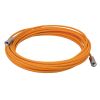Solinst AquaVent SPX Wellhead
Features
- Fits conveniently on 2" well casing with 4" adapter available
- (4) 1.5V AA lithium batteries last up to 8 years with 1 reading per minute
- Contains built-in desiccants with hydrophobic filter for maintenance-free operation
- Free ground shipping
- Expedited repair and warranty service
- Lifetime technical support
- More
Overview
The Solinst AquaVent SPX Wellhead fits conveniently onto a 2" (50 mm) well casing (a 4" Well Adaptor is available). The wellhead has a connection for communicating with Solinst software and accessories, along with an additional connection for communicating with third-party dataloggers or telemetry systems using MODBUS (RS-232/RS-485) or SDI-12 protocols.
Power
Each Wellhead contains four (4) 1.5V AA lithium batteries that power the AquaVent logger. They are user-replaceable and can last 8 years based on 1 reading per minute (the internal AquaVent logger battery is only used to maintain the clock).
Design
For permanent moisture protection, the Wellheads contain multiple built-in desiccants and have a hydrophobic filter where the vented cable terminates at the surface.
- (1) AquaVent Wellhead
- (1) Well sleeve, 2"
- (1) Cable hanger bracket
- Solinst AquaVent Vented Water Level Logger Specifications
- Solinst AquaVent Vented Water Level Logger Manual
- Solinst AquaVent Vented Water Level Logger Quick Start Guide
- Solinst AquaVent Vented Water Level Logger SDI-12 Manual
- Solinst AquaVent Vented Water Level Logger Modbus Manual
- Solinst AquaVent Vented Water Level Logger Cable Maintenance
- Solinst AquaVent Vented Water Level Logger Hardware Compatibility
In The News
Stone Lab: Cyanobacteria Monitoring in Ohio Lakes
Microcystin, one of several toxins produced by the cyanobacteria that form harmful algal blooms (HABs), has become a popular topic of lake research as the human health impacts of HABs become better understood. Stone Lab is one of the leading groups in algal bloom research on Lake Erie and other lakes in Ohio. For more than 100 years, Stone Lab has conducted biology research and provided science education and outreach to the region. Over the years, thousands of individuals of varying ages have learned from the resources Stone Lab provides. Stone Lab’s Research Coordinator and Senior Researcher, Justin Chaffin, learned of Stone Lab while an undergraduate student at Bowling Green State University Fireland Campus.
Read MoreFrom Assessment to Angler: Continual Research Ensures Lake Erie Remains a Beacon of Freshwater Fishing
Lake Erie is well known for its abundant recreational fishing. Anglers come from across the country to try their luck at the “walleye capital of the world” and search for other freshwater species, such as bass, perch, and steelhead trout. As one of the world’s largest freshwater fisheries, much effort is made behind the scenes to maintain fishing opportunities for visitors to enjoy year after year, efforts that often go unnoticed by the public. One of the lake's most important economic and tourism centers is the city of Sandusky, home to the Sandusky Fisheries Research Station . As part of the Ohio Division of Wildlife, the unit serves as a base for assessing fish populations and managing harvest with partner agencies from around Lake Erie.
Read MoreHigh Definition Stream Surveys: Informed Management in Local Waterways
When it comes to environmental monitoring, new stream survey methodologies have revealed a great deal about water quality and streambed conditions over time. Such information can be particularly important in leading restoration initiatives and prioritizing management decisions. Historically, stream surveys have been conducted at a single point along the stream, with data then extrapolated for miles up and downstream. However, Brett Connell, Hydrologist and Director of Sales at Trutta Environmental Solutions, started developing a more intensive stream survey format in his master's program in 2010 at the University of Tennessee.
Read More
























